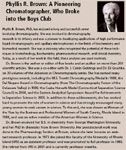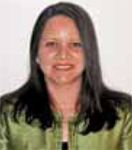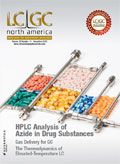Phyllis Brown: A Story of Serendipity, Perseverance, Vision, and Chromatography
LCGC North America
In the 1960s, high performance liquid chromatography (HPLC) was in its infancy and Phyllis Brown was a pioneer at the forefront of the technique.
In the 1960s, high performance liquid chromatography (HPLC) was in its infancy and Phyllis Brown was a pioneer at the forefront of the technique.
Hear more in a related podcast at: chromatographyonline.com/PhyllisBrown
Karyn M. Usher of West Chester University recently interviewed Phyllis R. Brown, professor emerita of the University of Rhode Island and former Editorial Advisory Board member of LCGC, about her distinguished career in chromatography.
Karyn Usher: How were you introduced to the field of chromatography?
Phyllis Brown: Serendipity played a large part in my becoming a chromatographer. After being out of the work world for 18 years, I went back to school, originally to get my chemistry up-to-date so I could work in a laboratory. But somehow I slid into the doctorate program and I received my PhD in chemistry from Brown University in 1968. My area of study was physical organic. However, my major professor was an inorganic chemist and my research was in the biochemical area. The year I started at Brown they gave their last analytical courses, which I took, and after that they no longer had an analytical area of specialization.
I was introduced to chromatography when I was working on my research. I had to separate the compounds in a reaction mixture and I started working with paper chromatography and thin-layer chromatography (TLC). My first papers, which were published in the Journal of Chromatography, were "A Quick TLC Test for the Detection of Mercaptan Groups in the Presence of Other Types of Sulfur Functional Groups" in 1968 (1) and "The Use of Thin-Layer Chromatography in Following Product Formation in the Photolysis of Alpha Lipoic Acid" in 1969 (2). I also became interested in gas chromatography (GC) and took a short course in it at the University of Rhode Island in the summer of 1962 or 1963.

After I graduated, I got a postdoctoral position in the Pharmacology Section at Brown. Their research was focused on purine and pyrimidine analogs for the treatment of cancer and other diseases. After I had been working for about a year, the head of the department came home from a conference and told the members of the group that he had seen an instrument called a "nucleic acid analyzer." He thought it would be useful to us in following the metabolism of the analogs we were investigating. Everyone in the group (all pharmacologists) turned their noses up at it because they were sure it wouldn't work; so the head of the department turned to me as the only chemist (as well as the newest member of the group) and said, "Phyllis, the instrument is yours. Because I don't want any white elephants in the lab, I have only rented it and you have three months to see if it works." The nucleic acid analyzer was an early high performance liquid chromatography (HPLC) system developed by Horvath and Lipsky specifically for the analysis of nucleotides and nucleosides (3,4).
I knew enough about chromatography in general and the theory of liquid chromatography (LC) to know it should work and that if I could get it working, it would be enormously useful in biochemistry and the biomedical sciences where the solutes were mainly water-soluble and nonvolatile. So, I worked night and day to get it operational and at the end of three months I put my first paper on HPLC on his desk (5). The paper sat on his desk for several weeks. I finally asked him about publishing it. He threw it across the desk at me and said, "You can publish it in one of YOUR journals and don't put MY name on it." I sent the article to the Journal of Chromatography. They accepted it within a few weeks and published it in three months. That is the fastest I have ever had an article accepted or published. In addition, since I was the sole author, I was acknowledged as the authority on the subject matter, which in general was the application of HPLC to biochemical and biomedical studies, and more specifically to the analysis of nucleotides and nucleosides.
Usher: You were one of the early workers in the field of chromatography during the 1960s. What was it like working with the technique in its infancy?
Brown: Working with the new technique of HPLC was fun, challenging, frustrating, and exciting. As I used to tell my students, early HPLC was part science, part art, and part black magic. It gave us the result we wanted, the analysis of the normally occurring nucleotides, in an hour. This analysis previously took a week to do by open-column chromatography. It improved the reproducibly tremendously and we did not have to do the analyses in a cold room. However, we had problems with the columns that broke down quickly, or with separations that were not reproducible from column to column. In addition, since it was a new technique, there was no literature to refer to set up the best operating conditions, so we had to use trial and error to optimize an analysis.
Usher: Describe your journey as a chromatographer. What were some of the highlights and challenges you faced in your research?
Brown: It is a wonder I ever survived as a chromatographer. Almost everyone in the field was an analytical chemist, an engineer, or a physical chemist, and of course they were all male. Along I came, an organic chemist with an interest in biochemistry and pharmacology, and an older woman at that. In addition, they were interested either in the theory of chromatography or in the instrumentation and I was interested in applying their toy to real problems. Their chromatograms, mainly of standards, were neat and clean with nice sharp peaks. My chromatograms of real samples were broad and sloppy looking with peaks of strange sounding compounds. The "old boys" didn't know what to make of me. For the most part, they ignored me. In fact, for several years they didn't tell me when the HPLC meetings were held. They were mainly by invitation and I didn't get invited. It took me a while to learn that most of the plans for the coming year were made in the bar in the evenings. By plans, I mean who was going to be invited to speak at next year's meeting, who they were going to support for awards, editorial boards, and so on. I then learned to go to the bar, sip my drink, and try to be part of "the boys."
The early years were heady. The results we got were exciting, especially optimizing the nucleic acid constituents, the nucleotides, the nucleosides, and their bases. We were among the first to use the new microparticle ion-exchange packings, and Fred Rabel of Whatman sent us some of the first reversed-phase packings, which were the answer to the problem of separating the nucleosides. We then began to apply our analyses to other biologically active compounds and to real biomedical studies. We started to collaborate with other institutions since I had moved to the University of Rhode Island and I was no longer connected to a medical school. I worked with institutions like NIH, Sloane Kettering Hospital, and Miriam and Rhode Island Hospitals in Providence, and companies like Waters, PerkinElmer, Pfizer, and Gillette.
A highlight of my career was when Howard Purnell, a very well known chromatographer, got up after my talk at an HPLC meeting in Amsterdam in the late 1970s and said that he thought that I gave the best talk at the conference. I believe he said the work was elegant and very exciting. It was a paper in which we showed that HPLC could be used to study the kinetics of the degradation of NADH, an important compound in biochemistry.
Usher: What do you believe is your greatest achievement in chromatography?
Brown: I believe that my greatest achievement was in being a pioneer in the application of HPLC to studies in the life sciences. I did something that the majority of chromatographers didn't dare to do; apply HPLC to real samples, especially complicated ones like blood. I had the vision to see the potential of the technique in the biological sciences and the foresight to predict it would open new horizons in medically oriented studies. It took a while for these predictions to come true because of the resistance of the biochemists. However, when columns became reliable and HPLC became interfaced with computers and mass spectrometry (MS), HPLC became a standard technique in almost every biomedical laboratory. Another achievement I am proud of is our work in developing and standardizing analyses of nucleic acid constituents. We have a large body of work in this area, making possible not only the analyses of the normally occurring constituents, which I believe made possible the later analysis of the human genome, but also being able to follow the kinetics of the metabolism of many purine and pyrimidine analogs.
Usher: During your career you mentored 71 graduate and undergraduate students. What were some of the most rewarding aspects of that area of your work?
Brown: I loved working with my students, especially my graduate students. I loved to see students come in very green as scientists and grow and mature, not only scientifically but also personally. They inspired me and gave me great ideas for research. I gave them great leeway and they rewarded me by taking me down roads I might not have traveled. I also liked working with freshmen to see if I could capture their imagination or perhaps get them over their fear of chemistry, especially the nurses. My career was much richer for my involvement with my students and I am grateful that I had the opportunity to work with them.
Usher: What are some of the challenges that you faced as a woman in a male-dominated field? Do you have any advice to offer women scientists today?
Brown: I faced more problems than I realized as a woman in chromatography. At first, when there was a call for papers at Pittcon or at the meetings of the analytical group at the American Chemical Society (ACS) meetings, I would send in abstracts that were accepted. However, when the HPLC group split from the general chromatography conferences run by Al Zlatkis, I was neither told about the meetings nor invited to attend. I finally overheard two of the organizers talking about the next meeting and enquired sweetly about the meeting. They looked at me in surprise and said, "Oh, would you like to attend?" Of course, I said yes and from then on I was invited. A few years later when Csaba Horvath was chairman of the HPLC meeting in New York, the meetings were finally opened to everyone and it was no longer an exclusive meeting of selected chromatographers. However, I noticed that no women were ever invited speakers or chaired sessions. In the mid-1980s, I started getting the women attendees together for lunch to talk about problems they encountered in their work and what women could do to get ahead in the field. I encouraged them to submit papers at meetings, to speak up at the various sessions, and to network with the other speakers. I was usually the only woman speaker and after a while I was finally asked to chair a session. It wasn't until the meeting in Basel in 1991 that I was asked to give the plenary talk. By this time, I was "one of the boys" and I was included in most of their get-togethers except for the planning sessions for the next meetings.
Another problem was that women were not asked to be on boards or committees, which is important for advancement in the field. For example, when I was asked to be on the board of Analytical Chemistry, I found out that in the history of the journal, only four women had been on the board. When I mentioned this to a board member, he laughed and said, "I am surprised that there were that many, knowing the people involved."
The advice I have to offer women scientists is that it is not enough to do good science. You have to let people know what good work you are doing by publishing and presenting your work at meetings as much as possible. Also be visible on the local, regional, and national scenes. Network and use mentors whenever possible and showcase your students' work by having them present papers at conferences.
Usher: In addition to your achievements as a scientist and professor, you also enjoyed a fulfilling personal life; being a wife, mother, grandmother, and great grandmother. What advice would you like to share about balancing professional and personal demands?
Brown: How to balance personal and professional demands is a tough question and the answers are highly individual. I was lucky because I really didn't start my scientific career until my children were older. I went back to school for my doctorate when my youngest child was in the first grade. She was in junior high when I went to work so I didn't have to balance a career and young children. In addition, my husband was very supportive; he encouraged and helped me in every way. We can't be superwomen and if possible you should use all the help you can get in taking care of your family and meeting the demands of your work.
Usher: Is there a current or historical scientist that you would have liked to have worked with during your career?
Brown: I would have loved to work with Gertrude Elion. I met her several times and she did fascinating work in pharmacology, developing drugs for the treatment of cancer and other diseases. She won the Nobel Prize in Medicine and Physiology even though she never had the chance to get a PhD. She was a wonderful person and a superb scientist and I felt privileged to know her.
Usher: Looking into your crystal ball, where do you see chromatography in the next 10 years?
Brown: This is a question I don't feel qualified to answer. I have not kept up with the literature and don't really know what has been accomplished in the field. A decade ago I would have said that instruments and analyses were going to get bigger and bigger and smaller and smaller. By that I meant that equipment was going to be developed for large-scale preparative separations and for nanotechnology. I am interested in analyses on a chip. Another area that intrigued me was developing the simplest instrumentation possible for separations for use in the field or in third-world countries where it was difficult or impossible to maintain complex instrumentation.
References
(1) P.R. Brown and J.O. Edwards, J. Chrom. 38, 543 (1968).
(2) P.R. Brown and J.O. Edwards, J. Chrom. 43, 515 (1969).
(3) C.G. Horvath, B.A. Press, and S.R. Lipsky, Anal. Chem. 39, 1422 (1967).
(4) C.G. Horvath and S.R. Lipsky, Anal. Chem. 41, 1229 (1969).
(5) P.R. Brown, J. Chrom. 52, 257 (1970).
This interview was edited for length and clarity.
More On-Line
In a podcast interview, Phyllis Brown talks more about her experiences as a woman in chromatography and offers advice for younger scientists. www.chromatographyonline.com/PhyllisBrown.
Karyn Usherobtained her PhD in Chemistry from The Florida State University under the direction of John G. Dorsey in 2005. She is currently an associate professor in the chemistry department at West Chester University of Pennsylvania.
Her current research focuses on sample preparation and quantitative analysis using HPLC and GC–MS. Her research projects have involved the use of solid-phase extraction, solid supported liquid–liquid extraction, and the QuEChERS technique to analyze a variety of analytes in complex matrices.

Karyn M. Usher

New TRC Facility Accelerates Innovation and Delivery
April 25th 2025We’ve expanded our capabilities with a state-of-the-art, 200,000 sq ft TRC facility in Toronto, completed in 2024 and staffed by over 100 PhD- and MSc-level scientists. This investment enables the development of more innovative compounds, a broader catalogue and custom offering, and streamlined operations for faster delivery. • Our extensive range of over 100,000 high-quality research chemicals—including APIs, metabolites, and impurities in both native and stable isotope-labelled forms—provides essential tools for uncovering molecular disease mechanisms and exploring new opportunities for therapeutic intervention.
New Guide: Characterising Impurity Standards – What Defines “Good Enough?”
April 25th 2025Impurity reference standards (IRSs) are essential for accurately identifying and quantifying impurities in pharmaceutical development and manufacturing. Yet, with limited regulatory guidance on how much characterisation is truly required for different applications, selecting the right standard can be challenging. To help, LGC has developed a new interactive multimedia guide, packed with expert insights to support your decision-making and give you greater confidence when choosing the right IRS for your specific needs.

.png&w=3840&q=75)

.png&w=3840&q=75)



.png&w=3840&q=75)



.png&w=3840&q=75)












